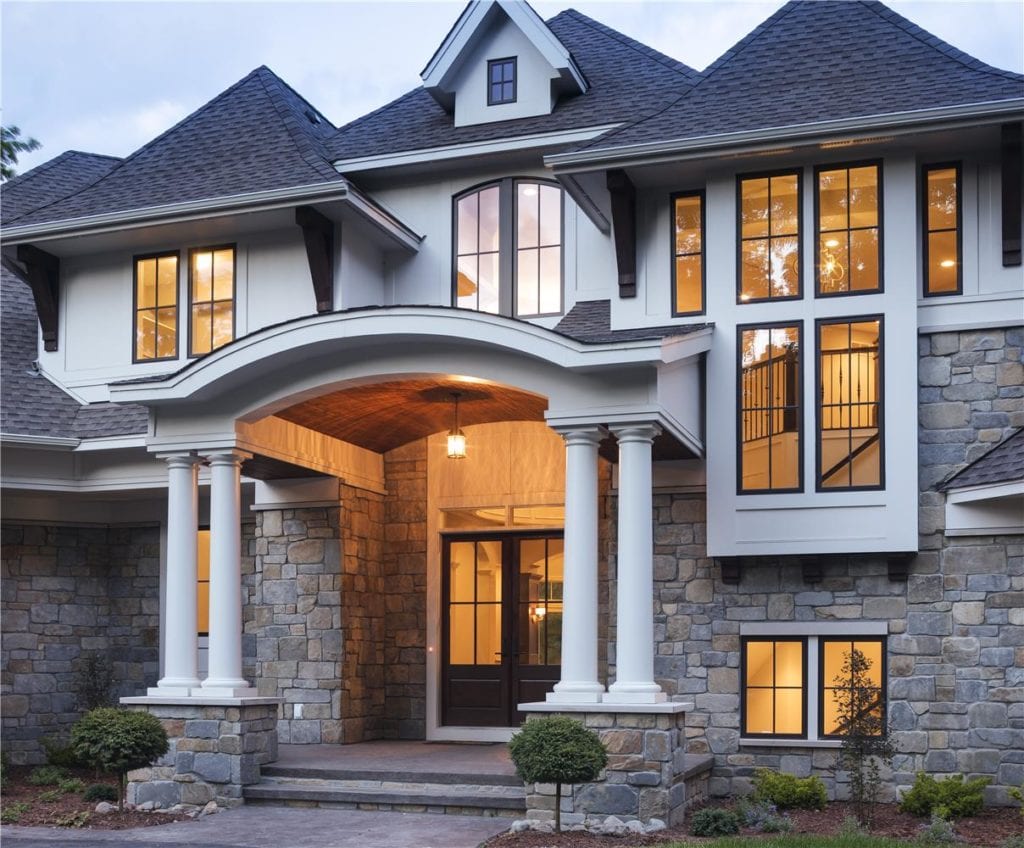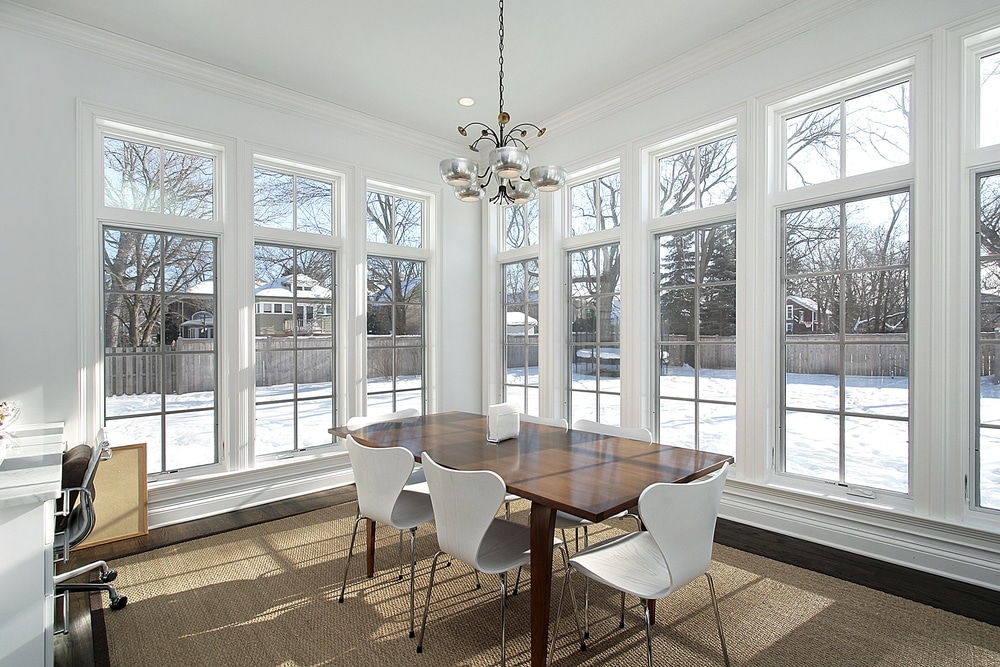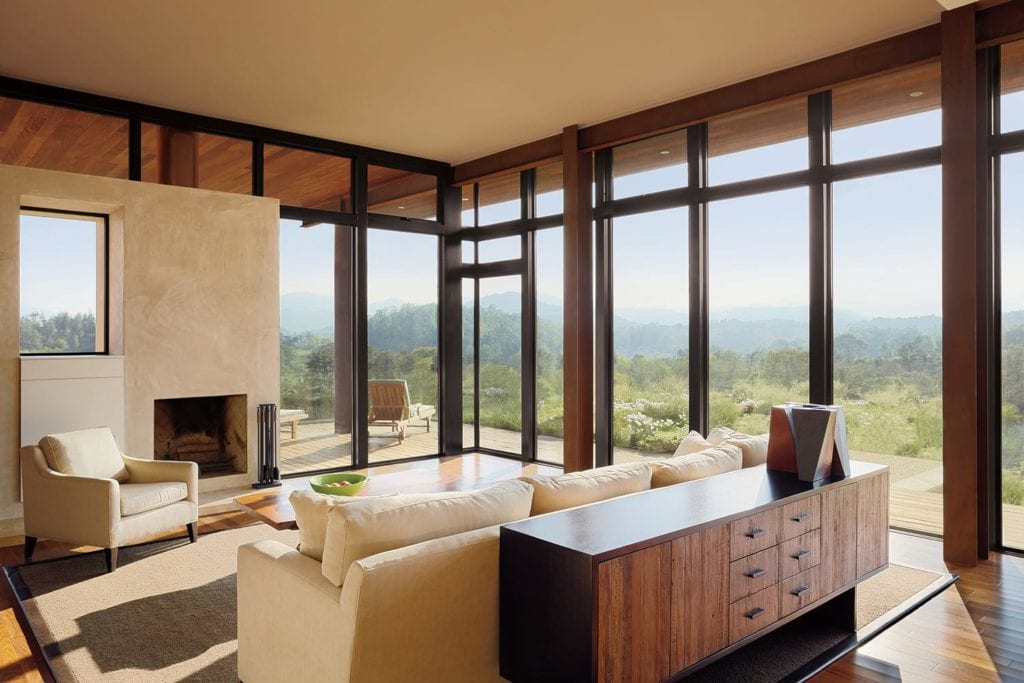If you’ve ever cranked up the heat in the middle of a Chicago winter only to feel cold drafts seeping in, or watched your living room overheat under the Madison summer sun, your windows may be to blame. Old or poorly insulated windows make it harder to stay comfortable and increase monthly energy bills.
That’s where energy-efficient windows help. With modern glass, frames, and coatings, they hold steady temperatures year-round. Industry estimates show that replacing single-pane windows with efficient models can cut energy bills by as much as 12 percent, which adds up quickly in a climate like Chicagoland or Madison, where heating and cooling systems run hard through all four seasons.
Table of Contents
How Windows Impact Home Energy Use
Windows play a major role in how your home holds heat in the winter and keeps cool air inside during the summer. Here’s how:
Heat Loss in Winter
During the colder months, older or poorly insulated windows allow warm indoor air to escape. Drafts form around the edges, and single-pane glass provides little resistance to the bitter cold outside. This forces your heating system to work harder, driving up energy bills.
Why it matters:
- Prevents chilly drafts in living spaces
- Keeps heating costs under control
- Reduces stress on your HVAC system
Heat Gain in Summer
Similar to how you may feel heat loss during winter, you can also experience increased heat during the summer. Sunlight that enters through older windows can rapidly warm the air inside, making rooms feel stuffy and uncomfortable. This effect is particularly noticeable in areas with large south-facing windows.
Modern glazing and coatings limit how much heat enters your home, creating more consistent indoor temperatures and lowering the need for constant air conditioning.
Why it matters:
- Keeps indoor spaces cooler and more comfortable
- Reduces reliance on air conditioning
- Prevents uneven temperatures from room to room

Key Features of Energy-Efficient Windows
Not all windows are created equal. The difference between a standard window and an energy-efficient one comes down to the materials, coatings, and construction details.
Glazing Types
Energy-efficient windows often feature double or even triple panes of glass, which provide insulation that single-pane windows simply can’t. Multi-pane glazing slows heat transfer, cuts drafts, and keeps rooms comfortable without overworking your HVAC.
The variety of window glass options available today makes it easier to choose the right balance of comfort, clarity, and efficiency for your home.
Why window glazing matters:
- Double or triple-pane windows slow down heat transfer
- Reduces drafts and cold spots near windows
- Improves comfort without overworking your HVAC system
Low-E Coatings
Low-emissivity (Low-E) coatings are ultra-thin layers on the glass that reflect heat to help regulate indoor temperatures.
Why low-e coatings matter:
- Blocks heat from entering during summer
- Reflects indoor warmth during winter
- Protects furniture and flooring from UV fading
Wondering if your windows can withstand the challenges of Chicago winters or Madison summers? At NEXT Door & Window, you’ll find low-e glass options designed for Midwest living, giving you natural light while keeping your home comfortable in every season.
Gas Fills
Have you ever thought about what’s between the panes of glass in your windows? In many energy-efficient designs, the space is filled with argon or krypton gas. These invisible gases act as insulation, slowing down the transfer of heat and making your windows more effective than the air-filled alternatives.
Why gas fill matters:
- Improves insulation without changing the look of the window
- Keeps indoor temperatures steadier in every season
- Enhances the efficiency of double- and triple-pane glazing
Frame Materials
Have you ever thought about how much the frame material influences a window’s efficiency? Vinyl, fiberglass, composite, and wood all perform differently. Vinyl and fiberglass are durable and low-maintenance, wood offers timeless curb appeal with strong insulation, and composites blend strength with style.
Why frame material matters:
- Different materials affect insulation and durability
- Impacts maintenance needs over time
- Helps customize efficiency and appearance for your style
Spacers & Seals
Have you noticed fog or condensation inside your window panes? That often signals problems with the spacers or seals. In energy-efficient windows, quality spacers keep panes at the right distance for insulation, while strong seals prevent air and moisture leaks. Quality spacers and tight seals protect against condensation, leaks, and drafts, so efficiency holds up year after year.
Why spacers matter:
- Prevents condensation buildup between panes
- Protects against drafts and air leakage
- Extends the life and performance of your windows
When these details are done right, you not only see the difference in your windows, you feel it every day in a more comfortable, consistent home.


Ratings and Certifications to Look For
Window labels can feel like alphabet soup, but a few terms make comparison simple.
ENERGY STAR Certification
The blue ENERGY STAR label is one of the most trusted symbols for efficiency. It means the window meets strict standards set by the U.S. Environmental Protection Agency, which reduces drafts and improves insulation.
Some products also carry the “Most Efficient” designation, which highlights the very best performers on the market. For homeowners, this label provides peace of mind that their windows are designed to save energy and lower monthly costs.
NFRC Label
Every certified window also comes with a National Fenestration Rating Council (NFRC) label. This label provides specific numbers that let you compare performance:
- U-Factor measures how well the window insulates
- Solar Heat Gain Coefficient (SHGC) indicates how much heat from the sun it blocks
- Visible Transmittance (VT) tells you how much natural light comes through
These numbers make it easy to see how a product balances insulation, solar control, and natural light so that you can choose the right fit for your home.
Local Codes
In Illinois and Wisconsin, windows also need to meet local building code requirements. For example, cold climates often require products with a low U-Factor to minimize heat loss, while humid summers make solar control equally important. Choosing windows that meet these standards ensures they perform well, pass inspections, and provide comfort through every season.
Costs, Savings, and ROI for Energy-Efficient Windows
Energy-efficient windows are an investment, but the return shows up in more ways than one. In Chicagoland and Madison, replacement windows typically range from a few hundred to over a thousand dollars, depending on size, frame material, and features.
While the upfront price can feel significant, ENERGY STAR estimates show savings of up to 12 percent on energy bills each year, with many homeowners seeing payback in seven to ten years.
Beyond lower bills, upgrades also create quieter rooms, better UV protection for floors and furnishings, and even a boost in resale value. Most importantly, they make your home more livable year-round, a difference you notice every time you step into a room that feels just right.

Climate Considerations: Chicago & Madison
Not all windows perform the same in every climate, which is why choosing ones suited to the Midwest makes such a difference. In Chicago and Madison, winters are cold and windy, making insulation critical. A low U-Factor ensures less heat escapes, keeping homes warmer without driving up heating costs.
Summers bring humid, sunny conditions, which make solar control just as important. Low-E coatings and the right SHGC rating block excess heat while still allowing natural light inside.
The Midwest also faces frequent freeze-thaw cycles, which can put stress on frames and seals. Strong materials like fiberglass or composite hold up well against these swings, ensuring long-term performance.
Living in Chicago or Madison means your windows need to pull double duty: keeping out the bitter cold in the winter and blocking intense sun in the summer. Choosing the right performance ratings and materials makes that balance possible.
How to Choose an Energy-Efficient Window Style
When considering energy-efficient windows for your home, it’s important to understand the different window designs available and their inherent efficiency characteristics. Here are the most common types:
Double-Hung Windows
- Traditional units are found in many homes, especially pre-war buildings
- Operate by sliding the bottom sash upward to open the window
- Can be efficient choices but may not be ideal for extreme climates due to potential air intrusion between the sliders
Casement Windows
- Popular in windy climates, as they seal themselves tighter when wind blows inward
- Equipped with a crank that swings the window outward to open
- Require maintenance on hinges and seals to ensure continued stability and efficiency
Picture Windows
- Typically non-operable and come in various shapes and sizes
- Despite not opening, picture windows can be efficient with the right glass choice and gas-filled interiors
Understanding the characteristics and considerations of each window type can help homeowners make informed decisions when selecting energy-efficient windows for their homes. Additionally, factors such as climate, maintenance requirements, and desired aesthetics should be taken into account to ensure optimal performance and comfort.
How to Choose the Right Window Contractor
Even the most advanced energy-efficient windows won’t perform as promised if they aren’t installed correctly. That’s why choosing the right contractor is just as important as choosing the right product.
Here are a few smart questions to ask before you decide:
- How much experience do you have with window replacement?
- What certifications or partnerships do you hold with window manufacturers?
- What warranties do you offer on both products and installation?
- Can you provide references or examples of past work?
It’s also wise to watch for red flags, like contractors who won’t put estimates in writing or who use vague language about timelines and warranties. Choosing a company with decades of experience and proven installation practices makes all the difference, which is exactly why homeowners in both Chicagoland and Madison choose NEXT Door & Window for results that impress and last.
Maintenance & Longevity of Energy-Efficient Windows
Installing energy-efficient windows is only the start. Simple care helps them deliver long-lasting value. Most high-quality windows last 20–30 years, but maintenance habits can make a big difference in their performance.
Simple steps like regularly cleaning the glass, wiping down frames, and checking seals for wear can prevent small issues from becoming bigger problems. Low-E glass should be cleaned gently with non-abrasive materials to avoid damaging the coating, while seals and caulking should be inspected annually. Neglecting these basics can shorten a window’s lifespan, reduce efficiency, and allow drafts or condensation to develop.
With consistent upkeep, your windows will continue to look great and perform efficiently for decades.
Choosing the Right Energy-Efficient Window for Your Home
Drafty winters and hot, sticky summers don’t have to be the norm in Chicagoland and Madison. With the right energy-efficient windows, you can enjoy lower energy bills, improved comfort, and lasting peace of mind.
Ready for a home that feels right every season? Contact NEXT Door & Window today to explore your options and schedule a window replacement service consultation. Whether you’re interested in Marvin Windows, specialized low-e Glass, or custom window material options, our team of Design & Energy experts will help you find the perfect fit for your home.
Comments are closed.


